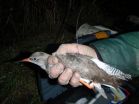(Press-News.org) BOSTON – November 28, 2012 – As part of their ongoing research on the role of genes in the development of type 1 diabetes, Joslin Diabetes Center scientists, in collaboration with scientists at the University of Würzburg, have demonstrated how a genetic variant associated with type 1 diabetes and other autoimmune diseases influences susceptibility to autoimmunity. The findings appear in the upcoming issue of Diabetes.
Recent studies of the human genome have identified genetic regions associated with autoimmune diseases such as type 1 diabetes. Joslin scientists in the Section of Immunobiology seek to understand how genes that are most widely associated with various autoimmune diseases contribute to disease risk.
One of these genes is PTPN22, which plays a role in lymphocyte (immune cell) function. A PTPN22 variant (or mutation) has been implicated as a risk factor for type 1 diabetes and several other autoimmune disorders. PTPN22 is involved in the formation of a key protein known as lymphoid tyrosine phosphatase (LYP), which helps control the activity of T and B cells in the immune system. The PTPN22 mutation generates a variation of LYP with a different molecular structure.
Most studies of the PTPN22 disease variant have suggested that this variant is a gain-of-function genetic mutation that enhances LYP activity and lessens the activity of T and B cells, which increases susceptibility to autoimmunity. "When immune cells are less reactive during the maturation phase of their development, the cells can evade mechanisms that help protect against autoimmunity," says study lead author Stephan Kissler, PhD, of the Section of Immunobiology. However, one study which analyzed data from humans and genetically modified mice suggested that the LYP variant associated with type 1 diabetes is a loss-of-function mutation that reduces LYP activity.
To help resolve the conflicting data, Joslin scientists conducted studies with a unique mouse model developed by Dr. Kissler's graduate student and co-author, Peilin Zheng. Using a technology that combines RNA interference, a method to silence gene expresson, with lentiviral transgenesis, a method to genetically modify animals, the scientists can manipulate gene activity in the most widely used mouse model for type 1 diabetes, the nonobese diabetic mouse (NOD). In this study, the researchers were able to easily turn off and on the PTPN22 gene in the NOD mouse. "We are the first to use this approach in the NOD mouse model," says Dr. Kissler. "It provides a very powerful way to study the contribution of PTPN22 to disease."
When PTPN22 was turned off in mice, mimicking a loss-of-function mutation, the researchers observed an increase in regulatory T cells and a decreased risk of autoimmune diabetes. "This is the first study conducted on the diabetic mouse model that supports the LYP gain-of-function hypothesis," says Dr. Kissler. "Our work should help to resolve the controversy."
By providing additional data that suggests the potential therapeutic value of PTPN22 manipulation, the study may further the development of new therapeutic options that inhibit LYP to reduce or prevent autoimmunity. "Our goal is to treat autoimmunity. Inhibiting LYP in patients may increase regulatory immune cells and could confer protection against autoimmunity, but it remains to be tested if our promising findings in this mouse model are reflected in humans," says Dr. Kissler.
The Joslin scientists are following up on this study to deepen understanding of how inhibiting PTPN22 affects T and B cells.
INFORMATION:
This research was funded in part by a Career Development Award from JDRF and with support from the German Research Foundation (Deutsche Forschungsgemeinschaft, DFG).
Joslin researchers increase understanding of genetic risk factor for type 1 diabetes
Finding may lead to treatment that protects against autoimmunity
2012-11-28
ELSE PRESS RELEASES FROM THIS DATE:
Record-setting X-ray jet discovered
2012-11-28
A jet of X-rays from a supermassive black hole 12.4 billion light years from Earth has been detected by NASA's Chandra X-ray Observatory. This is the most distant X-ray jet ever observed and gives astronomers a glimpse into the explosive activity associated with the growth of supermassive black holes in the early universe.
The jet was produced by a quasar named GB 1428+4217, or GB 1428 for short. Giant black holes at the centers of galaxies can pull in matter at a rapid rate producing the quasar phenomenon. The energy released as particles fall toward the black hole ...
Banking Industry Veteran Michael Sanchez Addresses Conference at IMPACT 2012 Venture Summit
2012-11-28
Savana Inc CEO Michael Sanchez, was one of several financial services industry executives invited to speak at the recently held IMPACT 2012 Venture Summit Mid-Atlantic hosted by the Greater Philadelphia Alliance for Capital and Technologies (PACT). Sanchez joined a panel to share his insight on trends in Fin-Tech and how the financial services industry is changing to support new business models through the use of software-based innovation.
Over a thousand attendees participated in the two day summit which featured speakers including former AOL Chairman Steve Case, former ...
4 common antipsychotic drugs found to lack safety and effectiveness in older adults
2012-11-28
In older adults, antipsychotic drugs are commonly prescribed off-label for a number of disorders outside of their Food and Drug Administration (FDA)-approved indications – schizophrenia and bipolar disorder. The largest number of antipsychotic prescriptions in older adults is for behavioral disturbances associated with dementia, some of which carry FDA warnings on prescription information for these drugs.
In a new study – led by researchers at the University of California, San Diego School of Medicine, Stanford University and the University of Iowa, and funded by the ...
The hungry caterpillar: Beware your enemy's enemy's enemy
2012-11-28
When herbivores such as caterpillars feed, plants may "call for help" by emitting volatiles, which can indirectly help defend the plants. The volatiles recruit parasitoids that infect, consume and kill the herbivores, to the benefit of the plant. However, such induced plant odours can also be detected by other organisms. A new study published November 27 in the open access journal PLOS Biology shows how secondary parasitoids ('hyperparasitoids') can take advantage of these plant signals to identify parasitoid-infected caterpillars, and duly infect the primary parasitoid, ...
Studies examine whether therapies for heart failure are associated with improved survival
2012-11-28
CHICAGO – An analysis of two heart failure therapies finds differing outcomes regarding improvement in survival, according to two studies appearing in the November 28 issue of JAMA.
In one study, Adrian F. Hernandez, M.D., M.H.S., of the Duke Clinical Research Institute, Durham, N.C., and colleagues examined the clinical effectiveness of aldosterone antagonist therapy and associations with long-term outcomes of older patients discharged from a hospitalization for heart failure.
"Aldosterone antagonist therapy [a diuretic drug] for heart failure and reduced ejection ...
Heart failure drug less effective in real world
2012-11-28
DURHAM, N.C. – A large study addressing the effectiveness and safety of aldosterone antagonist therapy for older heart failure patients has found notable differences between the drug's results in clinical trial vs. what occurs in actual practice, according to researchers at Duke Medicine.
Those differences have been noted anecdotally by doctors, and likely contributed to the slow adoption of aldosterone antagonists in clinical practice, but they had not been confirmed in a large study examining the drugs in real-world situations.
The Duke-led research, published Nov. ...
Risk of pertussis increases as time since last dose of DTaP vaccine lengthens
2012-11-28
CHICAGO – In an examination of cases of childhood pertussis in California, researchers found that children with pertussis had lower odds of having received all 5 doses of the diphtheria, tetanus, and acellular pertussis vaccine (DTaP) vaccine series; however the odds increased as the time since last DTaP dose lengthened, which is consistent with a progressive decrease in estimated vaccine effectiveness each year after the final dose of DTaP vaccine, according to a study in the November 28 issue of JAMA.
"Pertussis remains a poorly controlled vaccine-preventable disease ...
Study examines anticoagulation treatment following aortic valve replacement
2012-11-28
CHICAGO – Although current guidelines recommend 3 months of anticoagulation treatment after bioprosthetic aortic valve replacement surgery, a study that included more than 4,000 patients found that patients who had warfarin therapy continued between 3 and 6 months after surgery had a lower rate of cardiovascular death, according to a study in the November 28 issue of JAMA.
"Biological prostheses are preferred to mechanical valves for aortic valve replacement (AVR) surgery in elderly patients older than 65 years because of shorter life expectancy and lack of a need to ...
How infidelity helps nieces and nephews
2012-11-28
SALT LAKE CITY, Nov. 27, 2012 – A University of Utah study produced new mathematical support for a theory that explains why men in some cultures often feed and care for their sisters' children: where extramarital sex is common and accepted, a man's genes are more likely to be passed on by their sister's kids than by their wife's kids.
The theory previously was believed valid only if a man was likely to be the biological father of less than one in four of his wife's children – a number that anthropologists found improbably low.
But in the new study, University of ...
Ecologists shed new light on effects of light pollution on wildlife
2012-11-28
Coasts and estuaries are among the most rapidly developing areas on Earth. Night-time satellite images of the planet show that except Antarctica, continents are ringed with halos of brightly-lit human development. But coasts are also key wildlife sites. Every year, millions of waterbirds arrive from the Arctic to overwinter on UK coasts, yet scientists remain largely in the dark about how these birds respond to the bright lights of coastal cities and industry.
To shed light on the issue, Dr Ross Dwyer and colleagues from the University of Exeter investigated how artificial ...
LAST 30 PRESS RELEASES:
A new way to map how cells choose their fate
Numbers in our sights affect how we perceive space
SIMJ announces global collaborative book project in commemoration of its 75th anniversary
Air pollution exposure and birth weight
Obstructive sleep apnea risk and mental health conditions among older adults
How talking slows eye movements behind the wheel
The Ceramic Society of Japan’s Oxoate Ceramics Research Association launches new international book project
Heart-brain connection: international study reveals the role of the vagus nerve in keeping the heart young
Researchers identify Rb1 as a predictive biomarker for a new therapeutic strategy in some breast cancers
Survey reveals ethical gaps slowing AI adoption in pediatric surgery
Stimulant ADHD medications work differently than thought
AI overestimates how smart people are, according to HSE economists
HSE researchers create genome-wide map of quadruplexes
Scientists boost cell "powerhouses" to burn more calories
Automatic label checking: The missing step in making reliable medical AI
Low daily alcohol intake linked to 50% heightened mouth cancer risk in India
American Meteorological Society announces Rick Spinrad as 2026 President-Elect
Biomass-based carbon capture spotlighted in newly released global climate webinar recording
Illuminating invisible nano pollutants: advanced bioimaging tracks the full journey of emerging nanoscale contaminants in living systems
How does age affect recovery from spinal cord injury?
Novel AI tool offers prognosis for patients with head and neck cancer
Fathers’ microplastic exposure tied to their children’s metabolic problems
Research validates laboratory model for studying high-grade serous ovarian cancer
SIR 2026 delivers transformative breakthroughs in minimally invasive medicine to improve patient care
Stem Cell Reports most downloaded papers of 2025 highlight the breadth and impact of stem cell research
Oxford-led study estimates NHS spends around 3% of its primary and secondary care budget on the health impacts of heat and cold in England
A researcher’s long quest leads to a smart composite breakthrough
Urban wild bees act as “microbial sensors” of city health.
New study finds where you live affects recovery after a hip fracture
Forecasting the impact of fully automated vehicle adoption on US road traffic injuries
[Press-News.org] Joslin researchers increase understanding of genetic risk factor for type 1 diabetesFinding may lead to treatment that protects against autoimmunity




